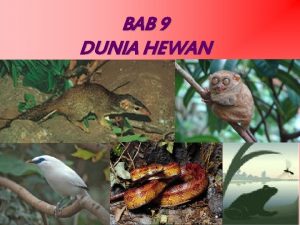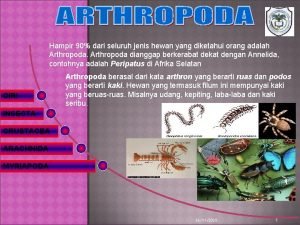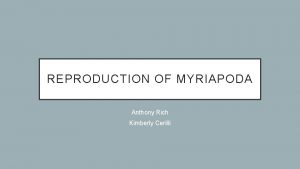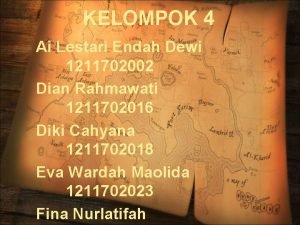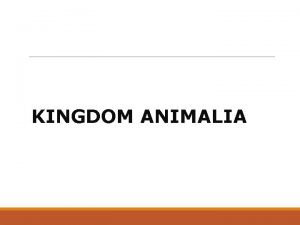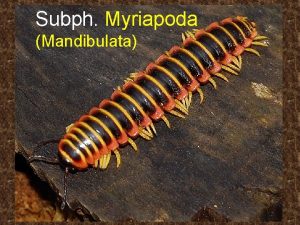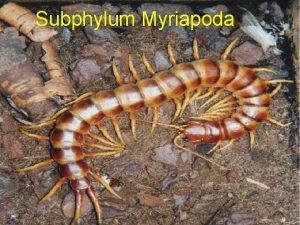Myriapoda Ecology Mia Yockey Kyle Douglass http www














- Slides: 14

Myriapoda Ecology Mia Yockey Kyle Douglass http: //www. bobjensenphotography. com//bobjensenphotography/gallery. asp ? photo. ID=35859&cat=94785

Identifying the organism The organism is the House Centipede, it was easy to tell with the many legs it had. The shape was obviously that of a centipede, it wasn’t too difficult to figure out http: //biologybizarre. blogspot. com/2013/09 /house-centipedes-getting-to-know-my. html

Centipede (Chilopoda) Habitat • Typically live in places with high levels of moisture ( especially tropical areas) • But they can live in deserts (Giant Centipede) • They found everywhere except Antarctica http: //www. naturespot. org. uk/species/banded-centipede

Centipede Diet • Centipedes are all carnivorous, eating: insects, spiders • If large enough they can eat birds, bats, rodents and giant spiders and even other Myriapoda http: //news. bbc. co. uk/2/shared/spl/hi/pop_ups/05/sci_nat_life_in_the_undergrow th/html/7. stm

Centipede Food web • Though centipedes are predatory organisms, they are also prey for a lot of organisms as well. http: //www. besgroup. org/ 2011/09/06/brown-shrikeimpaling-caterpillar-beforeeating-it/

Food web https: //www. pinterest. com/btnutrition 0140/soil-food-web/

Millipede (Diplopodia) Habitat • Much like centipedes, they like to live areas that are very damp and are commonly found in tropical areas http: //www. bbc. co. uk/nature/20323160

Millipede Diet • They are detritivores, eating decaying plants and feces of herbivores(some are carnivores) • They are very essential decomposes in tropical rainforests • They keep nutrients in the soil, which is vital to plants and other organisms that live in rainforests http: //aqualandpetsplus. com/Bug, %20 Millipedes%20 II. htm

Food web http: //paradise-lawn. com/the-soil-food-web-and-your-lawn/

Symphyla • The pseudo centipedes, much like the other classes, they too live in damp areas, and live in forested areas as well • They important detritivores to forests, with supplying nutrients to the soil https: //www. chaosofdelight. org/symphyla/

Pauropoda • They live around leaf litter and in damp places (like other classes). • They are detritivores and are also important decomposers for the forests and the plants in them http: //keys. lucidcentral. org/keys /v 3/TFI/start%20 key/myriap oda%20 key/Media/HTML/Pauro poda. htm l

Similarities • The waxy cuticle • The segmented body • The multiple sets of legs • Living damp areas / https: //www. chaosofdelight. org/pauropoda

Differences • Centipedes have the tail foot and are carnivorous • Millipedes, pauropods and Symphyla are all dritritivores • Some millipedes are carnivorous https: //commons. wiki media. org/wiki/File: Na rceus_americanus. jpg

Sources • https: //a-z-animals. com/animals/centipede/ • http: //www. biokids. umich. edu/critters/Diplop oda/ • http: //tolweb. org/pauropoda/2531 • https: //www. chaosofdelight. org/symphyla/
 Https://a-z-animals.com/
Https://a-z-animals.com/ Uroctonus mondax
Uroctonus mondax Sistem peredaran darah chilopoda
Sistem peredaran darah chilopoda Myriapoda reproduction
Myriapoda reproduction Myriapoda adalah gabungan dari kelas
Myriapoda adalah gabungan dari kelas Amphineura
Amphineura Hemichordata
Hemichordata Katie douglass
Katie douglass House slave
House slave Courtney douglass
Courtney douglass Frederick douglass learning to read and write
Frederick douglass learning to read and write Crouching servility
Crouching servility Talbot county maryland frederick douglass
Talbot county maryland frederick douglass Anna murray-douglass
Anna murray-douglass Frederick douglass and harriet jacobs
Frederick douglass and harriet jacobs

